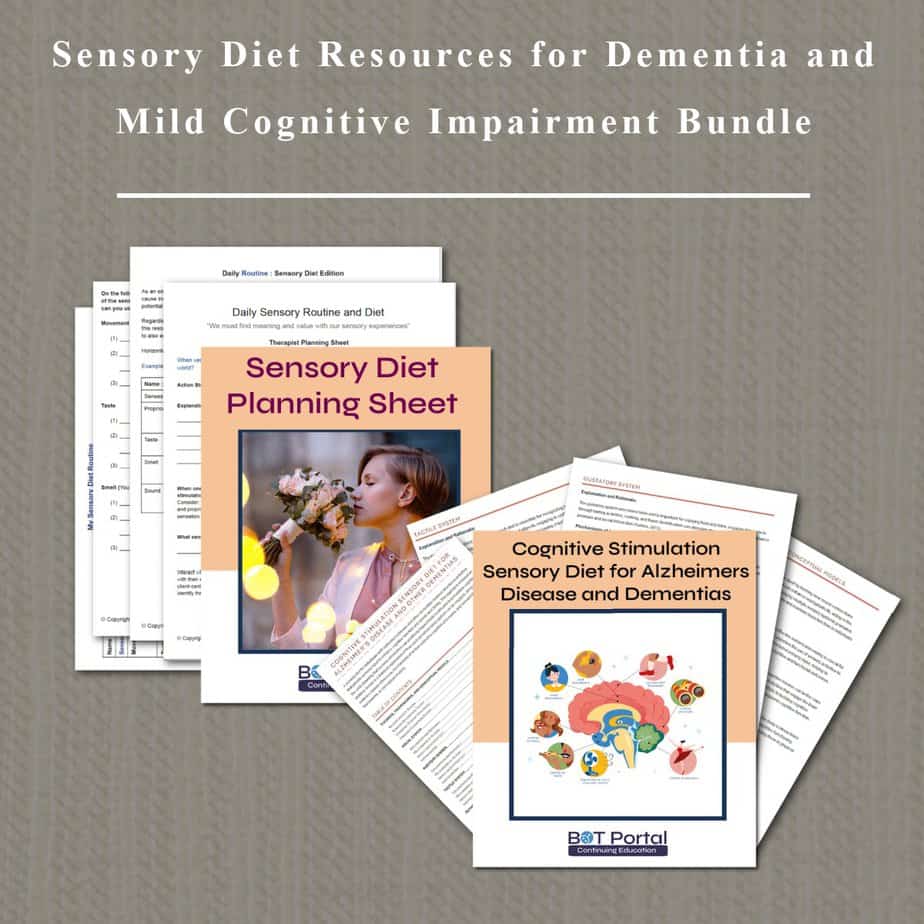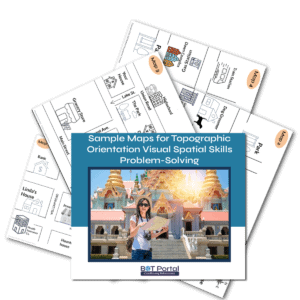Description
Sensory Diet for Dementia and Mild Cognitive Impairment Enhancement Bundle
Sensory Diet and Cognitive Resources for Occupational Therapy
The Sensory Diet OT Resource Bundle is an invaluable tool for occupational therapists, patients, and caregivers, designed to enhance the daily lives of individuals with cognitive or sensory processing challenges. This comprehensive bundle provides detailed resources to help therapists explore, create, and implement personalized sensory diets, ensuring all sensory systems are addressed to support optimal functioning and participation in daily activities.
1. Sensory Diet for Cognitive Stimulation and Enhancement
This resource offers a thorough explanation and practical strategies for using sensory diets to stimulate cognitive function and enhance the quality of life for individuals with Alzheimer’s disease and other dementias. Key components include:
- Detailed Interventions: Specific activities tailored for each sensory system (visual, auditory, tactile, olfactory, gustatory, vestibular, and proprioceptive) with explanations of their mechanisms of action and impacts on cognitive processes.
- Evidence-Based Practices: Grounded in theories of neuroplasticity, sensory integration, cognitive reserve, and embodied cognition, this resource provides a solid foundation for understanding and applying sensory diets in therapeutic settings.
- Customized Activities: Practical ideas for interventions and home activities that can be easily implemented to provide consistent sensory input, promote cognitive engagement, and enhance emotional well-being.
2. Printable Sensory Diet Packet
This user-friendly, printable packet is designed for therapists to use with their patients and caregivers. It includes essential tools to create and maintain effective sensory diets:
- Sensory Diet Information and Explanation: A comprehensive overview of what sensory diets are, their importance in occupational therapy, and how they can be tailored to meet individual needs.
- Sensory-Motor Guide: A detailed guide to help therapists determine which parts of the sensory system need attention to improve motor output and overall functionality.
- Client Handout for Home Exercise: A practical handout that caregivers can use to implement sensory activities at home, ensuring that the patient receives the necessary sensory input throughout their day.
More Information on Sensory Diets
In occupational therapy, sensory diets are carefully curated schedules of sensory activities designed to help individuals regulate their sensory experiences and participate more fully in daily activities. Here’s a closer look at the key aspects:
What is a Sensory Diet?
A sensory diet is a personalized plan of sensory activities tailored to an individual’s sensory needs, promoting self-regulation and enhancing participation in everyday tasks. Just as a balanced diet nourishes the body, a sensory diet nourishes the sensory system, providing the right amount and variety of sensory input for optimal functioning.
Key Components of a Sensory Diet:
- Assessment: Conduct thorough assessments to understand sensory processing patterns, preferences, sensitivities, and challenges.
- Sensory Modulation: Provide a combination of sensory inputs to achieve optimal arousal and regulation.
- Individualization: Tailor sensory activities to align with each person’s unique sensory profile, developmental stage, and daily routines.
- Collaboration: Involve caregivers, educators, and other professionals to integrate sensory strategies into various settings.
- Adaptive Strategies: Offer sensory tools and activities to help individuals self-regulate throughout the day.
Benefits of Sensory Diets in OT:
- Improved Self-Regulation: Develop self-awareness and self-regulation skills for better management of sensory challenges.
- Enhanced Engagement: Better engagement in meaningful occupations such as schoolwork, social interactions, and self-care tasks.
- Increased Functionality: Support the development of foundational skills necessary for independence and success.
- Promoting Sensory Integration: Facilitate sensory integration to promote adaptive responses and neural plasticity.
What is included?
- Original Sensory Diet Packet
- Sensory Diet for Dementia (Cognitive Simulation to enhance performance through the somatosensory cortex and cognitive processes)




